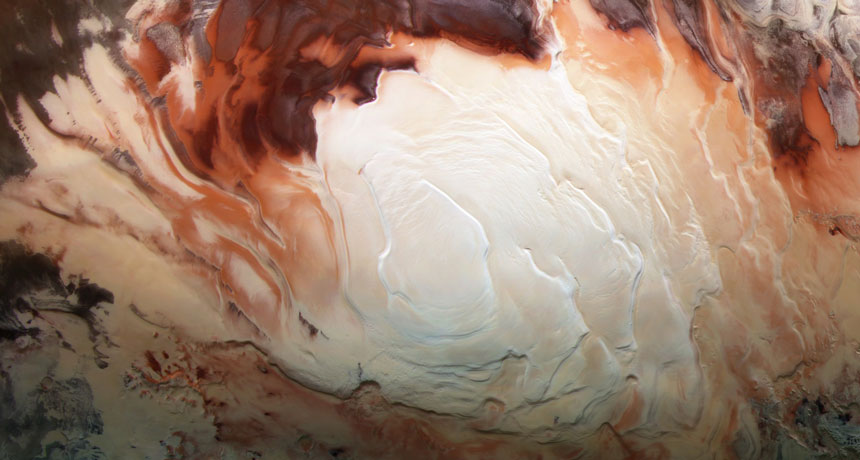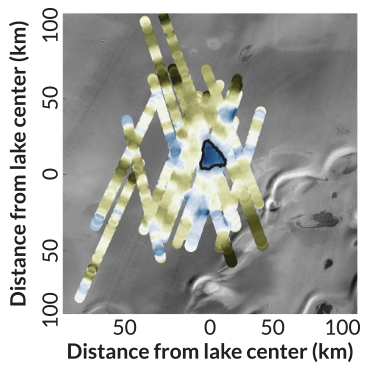A buried lake on Mars excited and baffled scientists
Liquid water under so much ice is a hard sell, and only one of two orbiters has detected it

HIDDEN DEPTHS Layers in the ice near Mars’ south pole, shown here in a 2012 composite image from the European Space Agency’s Mars Express orbiter, could conceal a briny lake buried 1.5 kilometers below the surface.
ESA, DLR, FU BERLIN, Bill Dunford
Headlines touting the discovery of water on Mars — again! — are a long-standing punchline among planetary scientists. But a discovery this year was something very different.
Unlike previous claims of water-bearing rocks or ephemeral streaks of brine, researchers reported in the Aug. 3 Science that they had found a wide lake of standing liquid near the Red Planet’s south pole, buried beneath 1.5 kilometers of ice (SN: 8/18/18, p. 6). The purported polar pool, spotted by an orbiting satellite, is the largest volume of liquid water ever claimed to currently exist on Mars, and has probably been around for a long time. Both of those features raise hopes that life could survive on Mars today.
But months after the announcement, the discovery remains controversial. First, it’s not clear how that water could remain liquid when the temperature at that icy depth should be about –68° Celsius. Even salts dissolved in the water would have a hard time melting ice that cold. “This is the main objection that has been raised,” says one of the lake’s discoverers, planetary scientist Roberto Orosei of the National Institute for Astrophysics in Bologna, Italy.
The other concern is that a second Mars orbiter, which should be able to detect such lakes, has seen nothing so far.
Orosei, however, thinks he has the answer to both puzzles: If Mars’ south polar ice cap has a texture like Styrofoam, he says, that could both insulate the lake and befuddle the other orbiter.
Orosei and colleagues spotted the lake after years of analyzing data from the European Space Agency’s Mars Express orbiter, which aims radar at the planet to see below its surface. As radar waves bounce off an interface between two materials, the brightness of the reflection can tell scientists what those materials are. Orosei’s group found a bright triangular reflection measuring about 20 kilometers across at Mars’ south pole. A lake of liquid water beneath the ice is the most likely explanation, Orosei says.
NASA’s Mars Reconnaissance Orbiter, which has also observed the south pole with radar, has seen no sign of the lake. “It’s a big mystery,” says Toronto-based planetary scientist Isaac Smith of the Planetary Science Institute, who works on the NASA mission. “We’d love to figure it out.”
Tiny pockets of air in the polar ice sheet might explain the conflicting radar results, Orosei suspects. If the ice is riddled with holes, they may scatter the Mars Reconnaissance Orbiter’s short-wavelength radar, like light filtering through a cloud. That scattering would hide the lake from the short-wavelength radar’s view. But Mars Express’ longer-wavelength radar could pass through the ice cleanly allowing it to reach and reflect off the lake.
The air in those holes would also help insulate lower layers of ice and raise the temperature there, or hold in heat from the planet’s interior more efficiently, similar to the way a Styrofoam cup keeps coffee hot.
“This is just a conjecture at the moment,” Orosei cautions.
Smith thinks porous, Styrofoam-like ice sounds plausible, but hard to explain. On Earth, ice normally packs tightly and becomes denser as it grows thicker. It’s hard to see how such a thick slab of ice on Mars would not do the same. Other orbital measurements suggest that Mars’ ice is even denser than regular water ice, which doesn’t leave much room for air holes.
But Mars’ south polar ice behaves differently than earthly ice in other ways too, Smith says. It doesn’t flow the way you would expect from tightly packed glaciers. Porous ice might explain why it flows differently, and more dust and other impurities in the ice could make up for the difference in density.
“It would be a big surprise,” Smith says. “But Mars is a unique place.”
If the ice is porous, there should be more insulated lakes hidden beneath the ice cap, Orosei says. The Mars Express team may have seen some hints of such lakes already, although it’s too early to be sure.
Finding additional lakes would be great news for the possibility of life there. If life took root in the past, it could still hang on in these long-lived subglacial lakes, like life does in similar lakes in Antarctica (SN: 9/20/14, p. 10).
“This means you would have a sort of Noah’s ark for life to exist today, if it ever developed on early Mars,” Orosei says. “The chances of finding extant life today would be much greater.”









